The Big, Bad Pollution Haze in Delhi and NCR left millions with a choked feeling, watery eyes or seriously sick. When will the laws be implemented and the guilty punished?
By Ramesh Menon
It is your right to breathe clean air. Ironically, over 17 million people in the capital and surrounding areas were gasping for breath last fortnight or struggling with throat and eye irritation as they faced the worst smog in 17 years. Many had to be hospitalized or be confined at home with oxygen cylinders. Under public pressure, the government shut schools, power plants and construction activity, promised to crack down on those setting garbage on fire and started cleaning roads of mounds of accumulated dust. It was a measure that was too little, too late.
In fact, 23 years ago, I had written about how Delhi was the most polluted city in the country and how it was becoming unliveable. I am doing it again. Nothing has changed. It has only got worse. In 2013, the WHO had said that air pollution and other environmental degradation cost India $80 billion per year, about 5.7 percent of the GDP.
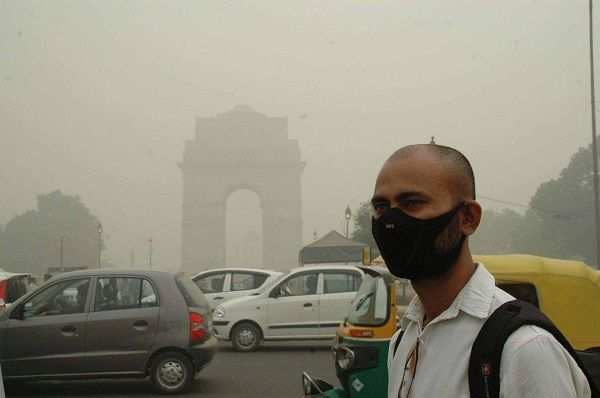
Despite the dire effects on health, no concrete action has been taken to punish the guilty. In Delhi, the level of particulate matter (PM) 2.5 is very high. This can seriously affect our health as it can penetrate lungs and the cardiovascular system, resulting in non-communicable diseases such as stroke, heart disease, lung cancer and acute respiratory diseases like asthma. The worst sufferers are children and the elderly as they are the most vulnerable.
PM basically refers to particle size less than 2.5 micrometers. To get an idea of how minute and invisible this is, a human hair is 60 to 70 micrometers. The Indian standard of PM 2.5 is 40 micrograms per meter cube. But the levels in Delhi were between 120-150 micrograms. According to WHO, health impacts start showing when it touches 10 micrograms.
Thankfully, the courts have taken note of the suffering of Delhiites. Justice Swatanter Kumar, chairperson of the National Green Tribunal, came down heavily on the Delhi government and neighboring states for their inaction: “What steps have you taken on the ground other than holding emergency meetings? Show us one thing on the ground that is being done and that has been effective?” Though an IIT Kanpur study had suggested comprehensive long-term and short-term measures starting from 2016 till 2023 to tackle air pollution in Delhi, it was ignored. Numerous governments have failed to arrest pollution. Unless it becomes an election issue, it is highly unlikely that anything will ever be done.
What steps have you taken (to control the pollution in New Delhi) on the ground other than holding emergency meetings? Show us one thing on the ground that is being done and that has been effective?
–National Green Tribunal
The deleterious effects of this pollution were seen in hospitals which reported a sudden rise of patients with respiratory problems. Paranoid citizens also scrambled for masks as chemists ran out of them. There was a sudden demand for air-purifiers. But Dr Vikram Sarbhai, senior consultant, chest, critical care and sleep medicine, National Heart Institute, said: “Installing air-purifiers on streets or even in houses is a stupid move as we are trying to purify infinity.” Incidentally, the Delhi government had announced that it would install giant air-purifiers in some of the most polluted road intersections.
While there is so much media and public attention on the condition prevailing in Delhi, no one is talking of other cities which too are struggling with bad air quality, some worse than Delhi. We need to worry about Allahabad, Gwalior, Patna, Raipur, Lucknow, Khanna, Kanpur, Agra, Amritsar and Ahmedabad. The toxic air in these cities includes formaldehyde, nickel, sulphur dioxide and nitrogen oxide.
Though high decibel television debates rocked living rooms as pollution was discussed, why has Delhi woken up all of a sudden to it? Everyone knew that there would be high levels of pollution during Diwali and a few days after it. So why didn’t the government restrict the sale of crackers?
Do you have a plan before the entire city (New Delhi) is shut down due to lethal pollution that has reached dangerous levels?
–Supreme Court
Pointed out Dr Sarbhai: “Pollution has been around for decades and nothing was done to tackle it. There has been a systematic failure in terms of town planning and regulation as even voters did not see it as an issue. Once the smog clears, it will be business as usual and television debates will move to some other controversy. Unless individuals take up responsibility to cut down pollution, nothing will happen. How many of us are ready to compromise our lifestyle and cycle to work, for instance?”
Stubble burning in Punjab and Haryana, another cause of pollution, is not a new phenomenon either. Farmers now use machines to harvest, leaving behind stubbles of about six to eight inches long. These are set on fire by farmers to flatten the earth before sowing. Many cannot afford to employ laborers to get rid of it.
Former environment minister Prakash Javdekar had issued 37 specific steps to tackle pollution after a meeting of environment ministers in 2015. He had asked states to ban stubble and waste burning, do effective dust management and phase out old vehicles. But it was not implemented.
About 300 million children worldwide are inhaling toxic air that can seriously hamper their developing brains. Apart from damaging children’s lungs, pollutants can cross the blood-brain barrier and permanently damage their developing brains and their future.
—Anthony Lake, executive director, UNICEF
Though Delhi and cities around it such as Gurugram, Faridabad, Noida and Ghaziabad was choking with the blinding smog, crackers were still burnt to celebrate Chhath Puja. It is pointless to blame the government when citizens themselves behave irresponsibly.
The Supreme Court minced no words recently when it said that multiple agencies manning Delhi should work out a common minimum program to save millions in the capital who are facing serious health ailments. It asked the center to submit a blueprint on how it proposes to tackle such a crisis. A bench headed by Chief Justice TS Thakur asked Solicitor General Ranjit Kumar: “Do you have a plan before the entire city is shut down due to lethal pollution that has reached dangerous levels?”
A report by an SC-appointed committee had termed the situation in Delhi a “public emergency”. Aparajita Singh, who was assisting the court as amicus curiae, told the bench that Delhi and its neighboring states were not following the orders of the apex court on pollution control.
Earlier this year, the Delhi government attempted to cut down pollution by restricting vehicles by coming out with the odd-even rule. But the level of particulate matter was still very high, clearly indicating that vehicles are not the only problem.
Earlier, the NGT had posed some tough questions. In April 2015, it had put a blanket ban on burning waste in the open and had imposed a fine of Rs 5,000 for violators. It wanted to know if any action had been taken against those who burn waste in the open. It asked if action had been taken against builders who flouted rules. It asked how the government was collaborating with officials in Punjab to stop burning of crop stalks. The government had no answers. “Mere investigation on papers won’t work. If officials don’t act on this, we will deduct their salary and, if needed, send them to jail,” the NGT warned.
Earlier this year, the Delhi government attempted to cut down pollution by restricting vehicles by coming out with the odd-even rule. But the level of particulate matter was still very high, clearly indicating that vehicles are not the only problem.
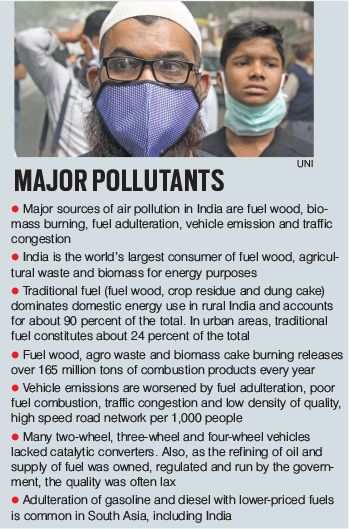 A report by IIT Kanpur had identified dust and exhaust from trucks as the chief culprit and not vehicles. PM 10 emission from dust is 79,626 kg and from PM 2.5, it is 2,165 kg every day, according to the report. The capital’s level of respirable suspended particulate matter is twice that of Beijing, one of the most polluted cities in the world. In fact, WHO ranked Delhi as the world’s most polluted big city.
A report by IIT Kanpur had identified dust and exhaust from trucks as the chief culprit and not vehicles. PM 10 emission from dust is 79,626 kg and from PM 2.5, it is 2,165 kg every day, according to the report. The capital’s level of respirable suspended particulate matter is twice that of Beijing, one of the most polluted cities in the world. In fact, WHO ranked Delhi as the world’s most polluted big city.
There is reason to worry. The number of vehicles in Delhi has tripled in the last decade. Anumita Roychowdhury, executive director, Centre for Science and Environment, who called Delhi a gas chamber, said that there has to be a restraint on the number of vehicles as toxic emissions from them was impacting health.
Knee-jerk reactions like spraying water on roads to stop dust from flying around are hardly the solution. As it is, there is a water crisis and it is a resource that should not be wasted like this. Mounds of dust on both sides of the road have to be collected and disposed off. Most of the time, it is taken off the road and deposited on the divider from where it again lands on the road. Dust is one of the major contributors to pollution and aggravates ailments like asthma.There is reason to worry. The number of vehicles in Delhi has tripled in the last decade. Anumita Roychowdhury, executive director, Centre for Science and Environment, who called Delhi a gas chamber, said that there has to be a restraint on the number of vehicles as toxic emissions from them was impacting health.
The Energy and Resources Institute (TERI) estimates that 35 percent of Delhi’s pollution comes from vehicles, construction dust and burning of refuse. In NCR, 25 percent comes from burning of domestic biomass, industries, transport and diesel generators. In regions beyond NCR, 40 percent of pollution comes from crop residue burning, domestic biomass burning and industries.
 The government should worry as it is not just the health of its citizens that is in jeopardy. High levels of pollution will also damage the economy. A survey by the Associated Chambers of Commerce and Industry of India (ASSOCHAM) said that 5-10 percent of the capital’s workforce had called in sick due to respiratory problems. It said that air pollution was preventing workers from doing their jobs efficiently. Tourism could be impacted, it warned. “Air pollution-related issues might hurt brand India,” said ASSOCHAM director general DS Rawat.
The government should worry as it is not just the health of its citizens that is in jeopardy. High levels of pollution will also damage the economy. A survey by the Associated Chambers of Commerce and Industry of India (ASSOCHAM) said that 5-10 percent of the capital’s workforce had called in sick due to respiratory problems. It said that air pollution was preventing workers from doing their jobs efficiently. Tourism could be impacted, it warned. “Air pollution-related issues might hurt brand India,” said ASSOCHAM director general DS Rawat.
One solution for this sorry state of affairs is to heavily fine polluters. Roads should be cleaned daily. Delhi may be one of the biggest cities in India, but only two vehicles with vacuum cleaners work! This was one of the facts revealed in court. Waste burning must also be heavily penalized and modern waste management practices should be put into place. If public transport does not improve, people will buy more cars.
Air quality expert Sumit Sharma, a Fellow at TERI, told India Legal: “One government alone cannot solve the problem. We need powerful action-oriented committees that can take multi-sectoral measures to cut down emissions. We need stringent emission standards. By 2020, India will move to Bharat Stage 6 emission level norms which will require state-of-the-art technology to be fitted into vehicles. Old vehicles should be strictly inspected with newer technologies so that even pollution control checks cannot be manipulated.”
Even Mexico came out with measures to tackle pollution. In the eighties, this country was one of the most polluted cities in the world. In 1986, Mexico drew up 21 measures to beat pollution. Natural gas began to replace fuel oil in industry and thermoelectric power generation.
For older vehicles, the government must adopt a fleet modernization program where it gives scrap value. This will encourage people to buy new vehicles that have better standards. A TERI University study showed that people are ready to move to public transport provided there is a safe and reliable mode available. Also, natural gas can be provided to industries that are using coal.
Thanks to sensitive environmentalists, a lot of damage has been prevented as they used the law to stop the senseless destruction and plunder that human greed was driving. Activists remember the role of Justice Kuldeep Singh who was popularly referred to as the Green Judge. Advocate MC Mehta has for the last two decades tirelessly fought cases to ensure that our environment is protected and the marauders do not get away.
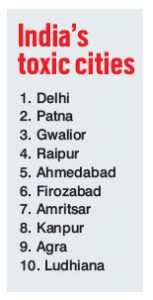 Chennai-based CPR Environmental Education Centre points out: “The judiciary has played a predominant role in ensuring that environmental practices are not just restricted to the law in paper, and have enforced and declared some major decisions that have come a long way in saving the environment. Though there are allegations that despite landmark judicial pronouncements, the executive and lack of will to save the environment has dampened the spirits of the judicial activism, it must be acknowledged that they have also been phenomenal in changing the course of environment destruction. The establishment of National Green Tribunals in 2010 and their active take on environmental issues have also added to such judicial gusto.”
Chennai-based CPR Environmental Education Centre points out: “The judiciary has played a predominant role in ensuring that environmental practices are not just restricted to the law in paper, and have enforced and declared some major decisions that have come a long way in saving the environment. Though there are allegations that despite landmark judicial pronouncements, the executive and lack of will to save the environment has dampened the spirits of the judicial activism, it must be acknowledged that they have also been phenomenal in changing the course of environment destruction. The establishment of National Green Tribunals in 2010 and their active take on environmental issues have also added to such judicial gusto.”
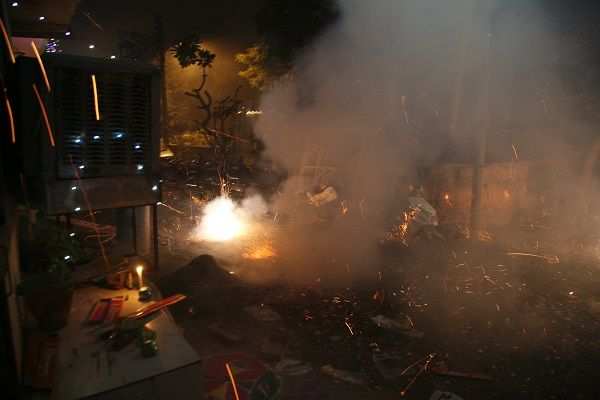 Cleaning up requires political will. There are so many examples all over the world to learn from. In 1957, the Thames was declared biologically dead by the Natural History Museum. That was 60 years ago. Today, it is teeming with some of the world’s most varied aquatic life such as seals, porpoises, sea horses, otters and stray whales.
Cleaning up requires political will. There are so many examples all over the world to learn from. In 1957, the Thames was declared biologically dead by the Natural History Museum. That was 60 years ago. Today, it is teeming with some of the world’s most varied aquatic life such as seals, porpoises, sea horses, otters and stray whales.
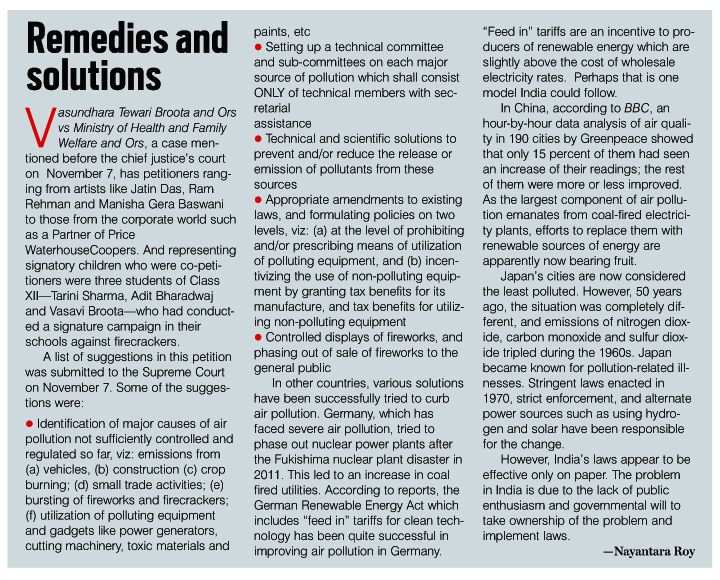 Old Victorian sewers that ensured that the river was clean were destroyed by bombings during World War I. Post-war Britain did not have the resources to fix it. But Thames was a lifeline which needed to be saved. The sewage system was gradually improved after the war. A charity was formed in the late seventies that was dedicated to improve London’s waterways. Strict regulations were imposed against the use of pesticides and fertilizers. New treatment plants were built. Laws were created against the dumping of untreated sewage in Thames. Embankments were built in 1891 narrowing the river and increasing the water flow, enabling it to more effectively remove waste. Can we do the same for the Yamuna? So much money has gone down the drain in cleaning it, but it remains as dirty as ever.
Old Victorian sewers that ensured that the river was clean were destroyed by bombings during World War I. Post-war Britain did not have the resources to fix it. But Thames was a lifeline which needed to be saved. The sewage system was gradually improved after the war. A charity was formed in the late seventies that was dedicated to improve London’s waterways. Strict regulations were imposed against the use of pesticides and fertilizers. New treatment plants were built. Laws were created against the dumping of untreated sewage in Thames. Embankments were built in 1891 narrowing the river and increasing the water flow, enabling it to more effectively remove waste. Can we do the same for the Yamuna? So much money has gone down the drain in cleaning it, but it remains as dirty as ever.
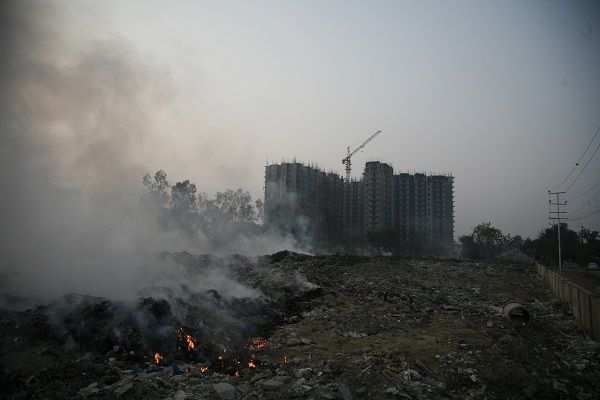 Even Mexico came out with measures to tackle pollution. In the eighties, this country was one of the most polluted cities in the world. In 1986, Mexico drew up 21 measures to beat pollution. Natural gas began to replace fuel oil in industry and thermoelectric power generation. In 1988, Mexico brought in a law that made federal authorities ensure emission reduction programs in areas under their jurisdiction. In 1989, city and regional governments restricted a fifth of all vehicles by rotating the days when they could ply depending on the last number on the registration plate. In 1990, verifying vehicles for pollution was made obligatory, supply of unleaded petrol was started and stricter vehicle emissions standards were imposed by introducing.
Even Mexico came out with measures to tackle pollution. In the eighties, this country was one of the most polluted cities in the world. In 1986, Mexico drew up 21 measures to beat pollution. Natural gas began to replace fuel oil in industry and thermoelectric power generation. In 1988, Mexico brought in a law that made federal authorities ensure emission reduction programs in areas under their jurisdiction. In 1989, city and regional governments restricted a fifth of all vehicles by rotating the days when they could ply depending on the last number on the registration plate. In 1990, verifying vehicles for pollution was made obligatory, supply of unleaded petrol was started and stricter vehicle emissions standards were imposed by introducing.
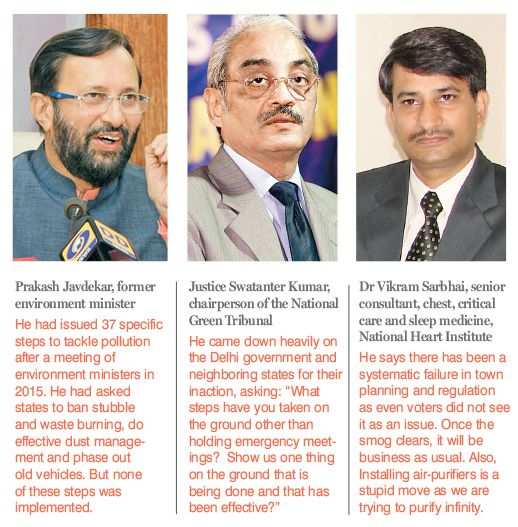 In 2001 and 2011, Mexico City’s fleet of taxis and minibuses was renovated, a Metro bus network was created and the Metro was further expanded. This systematic plan was put in place bit by bit.
In 2001 and 2011, Mexico City’s fleet of taxis and minibuses was renovated, a Metro bus network was created and the Metro was further expanded. This systematic plan was put in place bit by bit.
India too needs a systematic plan that can be executed in the next 20-25 years. After all, cleaning up takes time and strategic planning.
Lead picture: (L-R) A metro train zooms past smog in New Delhi; A couple wearing mask to avoid dangers of smog. Photo: Anil Shakya


